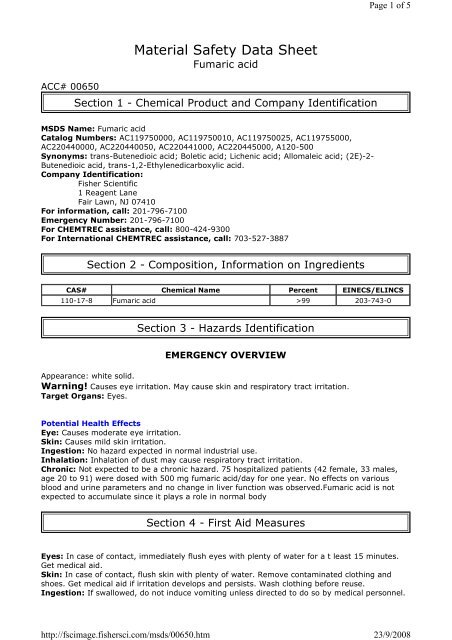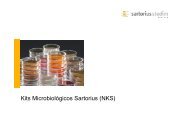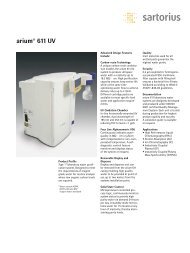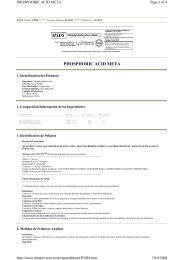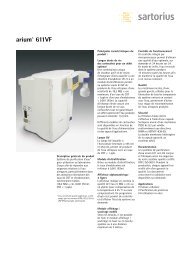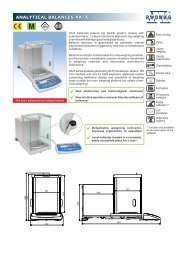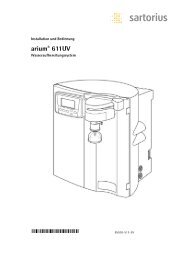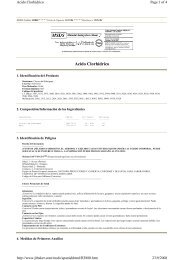Material Safety Data Sheet
Material Safety Data Sheet
Material Safety Data Sheet
You also want an ePaper? Increase the reach of your titles
YUMPU automatically turns print PDFs into web optimized ePapers that Google loves.
http://fscimage.fishersci.com/msds/00650.htm<br />
Page 1 of 5<br />
23/9/2008<br />
ACC# 00650<br />
<strong>Material</strong> <strong>Safety</strong> <strong>Data</strong> <strong>Sheet</strong><br />
Fumaric acid<br />
Section 1 - Chemical Product and Company Identification<br />
MSDS Name: Fumaric acid<br />
Catalog Numbers: AC119750000, AC119750010, AC119750025, AC119755000,<br />
AC220440000, AC220440050, AC220441000, AC220445000, A120-500<br />
Synonyms: trans-Butenedioic acid; Boletic acid; Lichenic acid; Allomaleic acid; (2E)-2-<br />
Butenedioic acid, trans-1,2-Ethylenedicarboxylic acid.<br />
Company Identification:<br />
Fisher Scientific<br />
1 Reagent Lane<br />
Fair Lawn, NJ 07410<br />
For information, call: 201-796-7100<br />
Emergency Number: 201-796-7100<br />
For CHEMTREC assistance, call: 800-424-9300<br />
For International CHEMTREC assistance, call: 703-527-3887<br />
Section 2 - Composition, Information on Ingredients<br />
CAS# Chemical Name Percent EINECS/ELINCS<br />
110-17-8 Fumaric acid >99 203-743-0<br />
Section 3 - Hazards Identification<br />
EMERGENCY OVERVIEW<br />
Appearance: white solid.<br />
Warning! Causes eye irritation. May cause skin and respiratory tract irritation.<br />
Target Organs: Eyes.<br />
Potential Health Effects<br />
Eye: Causes moderate eye irritation.<br />
Skin: Causes mild skin irritation.<br />
Ingestion: No hazard expected in normal industrial use.<br />
Inhalation: Inhalation of dust may cause respiratory tract irritation.<br />
Chronic: Not expected to be a chronic hazard. 75 hospitalized patients (42 female, 33 males,<br />
age 20 to 91) were dosed with 500 mg fumaric acid/day for one year. No effects on various<br />
blood and urine parameters and no change in liver function was observed.Fumaric acid is not<br />
expected to accumulate since it plays a role in normal body<br />
Section 4 - First Aid Measures<br />
Eyes: In case of contact, immediately flush eyes with plenty of water for a t least 15 minutes.<br />
Get medical aid.<br />
Skin: In case of contact, flush skin with plenty of water. Remove contaminated clothing and<br />
shoes. Get medical aid if irritation develops and persists. Wash clothing before reuse.<br />
Ingestion: If swallowed, do not induce vomiting unless directed to do so by medical personnel.
http://fscimage.fishersci.com/msds/00650.htm<br />
Page 2 of 5<br />
23/9/2008<br />
Never give anything by mouth to an unconscious person. Get medical aid.<br />
Inhalation: If inhaled, remove to fresh air. If not breathing, give artificial respiration. If<br />
breathing is difficult, give oxygen. Get medical aid.<br />
Notes to Physician: Treat symptomatically and supportively.<br />
Section 5 - Fire Fighting Measures<br />
General Information: As in any fire, wear a self-contained breathing apparatus in pressuredemand,<br />
MSHA/NIOSH (approved or equivalent), and full protective gear. During a fire, irritating<br />
and highly toxic gases may be generated by thermal decomposition or combustion. This material<br />
in sufficient quantity and reduced particle size is capable of creating a dust explosion.<br />
Extinguishing Media: Use water spray, dry chemical, carbon dioxide, or appropriate foam.<br />
Flash Point: Not applicable.<br />
Autoignition Temperature: 375 deg C ( 707.00 deg F)<br />
Explosion Limits, Lower:N/A<br />
Upper: N/A<br />
NFPA Rating: (estimated) Health: 2; Flammability: 1; Instability: 1<br />
Section 6 - Accidental Release Measures<br />
General Information: Use proper personal protective equipment as indicated in Section 8.<br />
Spills/Leaks: Vacuum or sweep up material and place into a suitable disposal container. Avoid<br />
generating dusty conditions. Provide ventilation.<br />
Section 7 - Handling and Storage<br />
Handling: Wash thoroughly after handling. Remove contaminated clothing and wash before<br />
reuse. Use with adequate ventilation. Minimize dust generation and accumulation. Avoid contact<br />
with eyes, skin, and clothing. Avoid breathing dust.<br />
Storage: Store in a cool, dry, well-ventilated area away from incompatible substances. Keep<br />
containers tightly closed.<br />
Section 8 - Exposure Controls, Personal Protection<br />
Engineering Controls: Use adequate ventilation to keep airborne concentrations low.<br />
Exposure Limits<br />
Chemical Name ACGIH NIOSH OSHA - Final PELs<br />
Fumaric acid none listed none listed none listed<br />
OSHA Vacated PELs: Fumaric acid: No OSHA Vacated PELs are listed for this chemical.<br />
Personal Protective Equipment<br />
Eyes: Wear appropriate protective eyeglasses or chemical safety goggles as described by<br />
OSHA's eye and face protection regulations in 29 CFR 1910.133 or European Standard EN166.<br />
Skin: Wear appropriate gloves to prevent skin exposure.<br />
Clothing: Wear appropriate protective clothing to minimize contact with skin.<br />
Respirators: Follow the OSHA respirator regulations found in 29 CFR 1910.134 or European<br />
Standard EN 149. Use a NIOSH/MSHA or European Standard EN 149 approved respirator if<br />
exposure limits are exceeded or if irritation or other symptoms are experienced.
http://fscimage.fishersci.com/msds/00650.htm<br />
Page 3 of 5<br />
23/9/2008<br />
Section 9 - Physical and Chemical Properties<br />
Physical State: Solid<br />
Appearance: white<br />
Odor: odorless<br />
pH: Not available.<br />
Vapor Pressure: 0.000154 mm Hg @ 25 deg C<br />
Vapor Density: Not available.<br />
Evaporation Rate:Not available.<br />
Viscosity: Not available.<br />
Boiling Point: Not applicable.<br />
Freezing/Melting Point:287 deg C<br />
Decomposition Temperature:200 deg C subli<br />
Solubility: 0.63g/100 g @ 25°C<br />
Specific Gravity/Density:1.625<br />
Molecular Formula:C4H4O4<br />
Molecular Weight:116.07<br />
Section 10 - Stability and Reactivity<br />
Chemical Stability: Stable. However, may decompose if heated. May polymerize.<br />
Conditions to Avoid: Dust generation, temperatures above 190°C, Corrosive to aluminum in<br />
aqueous solution..<br />
Incompatibilities with Other <strong>Material</strong>s: Strong oxidizing agents, strong reducing agents,<br />
strong bases, amines.<br />
Hazardous Decomposition Products: Carbon monoxide, carbon dioxide.<br />
Hazardous Polymerization: May occur.<br />
Section 11 - Toxicological Information<br />
RTECS#:<br />
CAS# 110-17-8: LS9625000<br />
LD50/LC50:<br />
CAS# 110-17-8:<br />
Draize test, rabbit, eye: 100 mg/24H Moderate;<br />
Draize test, rabbit, skin: 500 mg/24H Mild;<br />
Oral, rat: LD50 = 9300 mg/kg;<br />
.<br />
Carcinogenicity:<br />
CAS# 110-17-8: Not listed by ACGIH, IARC, NTP, or CA Prop 65.<br />
Epidemiology: No information available.<br />
Teratogenicity: No information available.<br />
Reproductive Effects: No information available.<br />
Mutagenicity: Please refer to RTECS# LS9625000 for specific information.<br />
Neurotoxicity: No information available.<br />
Other Studies:<br />
Section 12 - Ecological Information
http://fscimage.fishersci.com/msds/00650.htm<br />
Page 4 of 5<br />
23/9/2008<br />
Ecotoxicity: No data available. No information available.<br />
Environmental: Readily biodegradable.<br />
Physical: No information available.<br />
Other: No information available.<br />
Section 13 - Disposal Considerations<br />
Chemical waste generators must determine whether a discarded chemical is classified as a<br />
hazardous waste. US EPA guidelines for the classification determination are listed in 40 CFR<br />
Parts 261.3. Additionally, waste generators must consult state and local hazardous waste<br />
regulations to ensure complete and accurate classification.<br />
RCRA P-Series: None listed.<br />
RCRA U-Series: None listed.<br />
Section 14 - Transport Information<br />
US DOT<br />
Canada TDG<br />
Shipping Name: Not regulated Not Regulated<br />
Hazard Class:<br />
UN Number:<br />
Packing Group:<br />
Section 15 - Regulatory Information<br />
US FEDERAL<br />
TSCA<br />
CAS# 110-17-8 is listed on the TSCA inventory.<br />
Health & <strong>Safety</strong> Reporting List<br />
None of the chemicals are on the Health & <strong>Safety</strong> Reporting List.<br />
Chemical Test Rules<br />
None of the chemicals in this product are under a Chemical Test Rule.<br />
Section 12b<br />
None of the chemicals are listed under TSCA Section 12b.<br />
TSCA Significant New Use Rule<br />
None of the chemicals in this material have a SNUR under TSCA.<br />
CERCLA Hazardous Substances and corresponding RQs<br />
CAS# 110-17-8: 5000 lb final RQ; 2270 kg final RQ<br />
SARA Section 302 Extremely Hazardous Substances<br />
None of the chemicals in this product have a TPQ.<br />
Section 313 No chemicals are reportable under Section 313.<br />
Clean Air Act:<br />
This material does not contain any hazardous air pollutants.<br />
This material does not contain any Class 1 Ozone depletors.<br />
This material does not contain any Class 2 Ozone depletors.<br />
Clean Water Act:<br />
CAS# 110-17-8 is listed as a Hazardous Substance under the CWA.<br />
None of the chemicals in this product are listed as Priority Pollutants under the CWA.<br />
None of the chemicals in this product are listed as Toxic Pollutants under the CWA.<br />
OSHA:<br />
None of the chemicals in this product are considered highly hazardous by OSHA.<br />
STATE<br />
CAS# 110-17-8 can be found on the following state right to know lists: California, New
http://fscimage.fishersci.com/msds/00650.htm<br />
Page 5 of 5<br />
23/9/2008<br />
Jersey, Pennsylvania, Massachusetts.<br />
California Prop 65<br />
California No Significant Risk Level: None of the chemicals in this product are listed.<br />
European/International Regulations<br />
European Labeling in Accordance with EC Directives<br />
Hazard Symbols:<br />
XI<br />
Risk Phrases:<br />
R 36 Irritating to eyes.<br />
<strong>Safety</strong> Phrases:<br />
S 26 In case of contact with eyes, rinse immediately with plenty of<br />
water and seek medical advice.<br />
WGK (Water Danger/Protection)<br />
CAS# 110-17-8: 1<br />
Canada - DSL/NDSL<br />
CAS# 110-17-8 is listed on Canada's DSL List.<br />
Canada - WHMIS<br />
This product has a WHMIS classification of D2B.<br />
This product has been classified in accordance with the hazard criteria of the Controlled Products<br />
Regulations and the MSDS contains all of the information required by those regulations.<br />
Canadian Ingredient Disclosure List<br />
CAS# 110-17-8 is listed on the Canadian Ingredient Disclosure List.<br />
Section 16 - Additional Information<br />
MSDS Creation Date: 1/06/1999<br />
Revision #4 Date: 2/08/2008<br />
The information above is believed to be accurate and represents the best information currently available to us. However, we<br />
make no warranty of merchantability or any other warranty, express or implied, with respect to such information, and we<br />
assume no liability resulting from its use. Users should make their own investigations to determine the suitability of the<br />
information for their particular purposes. In no event shall Fisher be liable for any claims, losses, or damages of any third party<br />
or for lost profits or any special, indirect, incidental, consequential or exemplary damages, howsoever arising, even if Fisher has<br />
been advised of the possibility of such damages.


